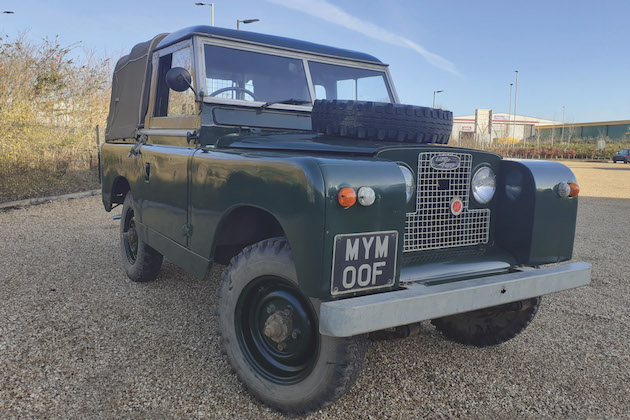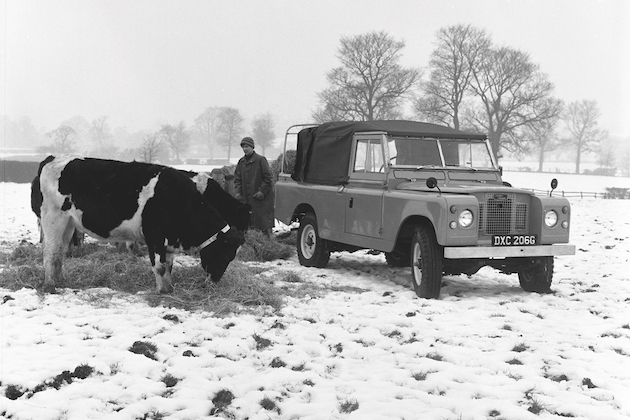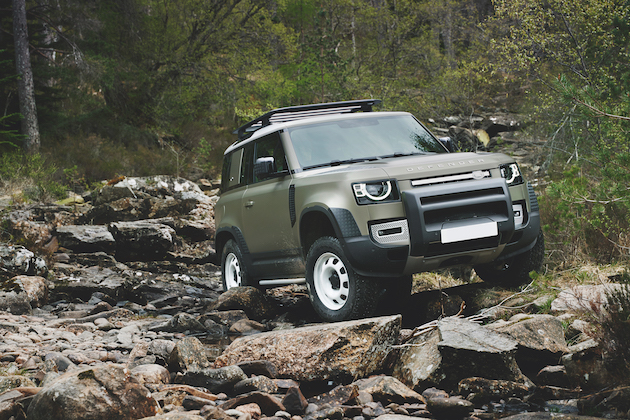Your most faithful shoot companion: celebrating the Land Rover Defender
Used on shoots to carry Guns between drives, store the shot game and provide shelter to dogs and Guns alike…
Win CENS ProFlex DX5 earplugs worth £1,149 – enter here
 1968 Land Rover Series 2A 88 inch (SWB) first registered 15/05/1968, chassis no. 24133026D, with V5 and keys, MOT & Tax exempt., no. former keepers 11, now in green, registration UYM 60F
Formally the property of the Late John Humphreys (1939 â 2012). An enthusiast and great ambassador for the countryside. One of the shooting communityâÂÂs foremost writers and a best-loved character, former teacher, jazz musician, sportsman, prolific writer of sporting books, for the Shooting Times and other country magazines, as well as a witty after dinner speaker. Used by the author in Lords Ground Shoot & Hunters Fen.
1968 Land Rover Series 2A 88 inch (SWB) first registered 15/05/1968, chassis no. 24133026D, with V5 and keys, MOT & Tax exempt., no. former keepers 11, now in green, registration UYM 60F
Formally the property of the Late John Humphreys (1939 â 2012). An enthusiast and great ambassador for the countryside. One of the shooting communityâÂÂs foremost writers and a best-loved character, former teacher, jazz musician, sportsman, prolific writer of sporting books, for the Shooting Times and other country magazines, as well as a witty after dinner speaker. Used by the author in Lords Ground Shoot & Hunters Fen.
During my childhood spent getting in the way at shoots, there was always a race to be the first to jump into the Land Rovers and secure the bumpiest ride to the lodge. We would eschew the comforts of the various Isuzus and Toyotas in favour of the rock-hard benches in the back of a Series III and be tossed around with the Labradors like popcorn in a pan.
The sight of endless dogs, Guns and children being disgorged from the back of a Land Rover is familiar to anyone, whether a seasoned gillie or a first-time up-from-Londoner. The vehicle’s bulldogish looks have captured the hearts of millions and it represents the British countryside.
Yet ask any Land Rover owner how their car is getting on and you will likely be met by a sigh, a groan or an anguished wail. Despite their boyish charm and can-do attitude on the most arduous terrain, Land Rovers are capricious. They may be able to drive you through a loch but will cause your leg to seize up if caught in light traffic. Older models are uncomfortable, unreliable, prone to rust and cumbersome to drive. Their brakes are heavy, their engines noisy and their safety features laughable.
Why do we keep returning to them as a shooting vehicle, and is buying one for sporting use ever a good idea?
It depends on the type of Land Rover in which you are interested. I’ve heard nothing but praise for the 2020 Defender. It is comfortable to drive, capable on all terrains, practical in town and country and looks cool. However, with prices starting at £45,000, it costs more than many would like to spend on a vehicle that will be used a handful of times a year.
Used on shoots to carry Guns between drives, store the shot game and provide shelter to dogs and Guns alike…
Can you imagine a countryside without the Land Rover? As a much-loved rural icon turns 60, Alastair Balmain reflects on…
With under £10k to spend, what are the best options? Thanks to their modular design, Land Rovers can come in almost infinite varieties on their basic form. They can be taken apart and modified for less than many a counterpart, so it is advisable to find a good base model and adapt it rather than scouring the country for the perfect pre-packaged example.
When considering an old Land Rover, it is important to consider how it will be used. There is little point in buying a Series IIA if you are going to use it as an everyday vehicle, or even a Series III. They look the part but are exhausting to drive for too long.
The Series II and IIA are considered by many to be a ‘proper’ Land Rover. The heavy mesh grille and closely positioned headlamps lend them a military air and allow the driver to imagine themselves scuttling across a dusty plain in a far-flung land. They are cars of adventure, surely the perfect companion to a day on the moor. Until you drive one.

The Series II is considred to be a ‘proper’ Land Rover, with a rather military air
A car specialist — who wished to remain anonymous — revealed that “their brakes are completely unassisted and unspeakably heavy compared with the most basic modern car. Their top speed is a generous 55mph and the steering is laborious at best. Generally there is no synchromesh on either first or second gear until the Series III, so unless you are used to double de-clutching, you will have a hard time even getting out of the starting blocks.”
Series III makes things somewhat easier on the driver, but it is just as afflicted as the earlier examples by notorious Land Rover corrosion. At a time of steel shortage following the war, aluminium was the material of choice for Land Rover to keep production costs down and purportedly avoid corrosion. The plan worked, within reason. The aluminium bodies of Land Rovers are relatively rust-free and can remain in good condition half a century on, but beneath the body lies a different story.
A sturdy car needs a sturdy chassis, which in Land Rover’s case is a ladder frame made of steel. Early models reportedly received a negligible amount of corrosion protection in production, and both the chassis and bulkheads are heavily impacted by corrosion — two of the most expensive parts to replace. Due to the Land Rover’s primitive driving style, it is often hard to notice a major fault in the mechanics until it is too late.

The 2020 Land Rover Defender is practical, comfortable and can handle all terrains
But if you are willing to sacrifice vintage charm for creature comforts, the Discovery could be the answer. For under £7,000 you could get an excellent Discovery 2 with a solid service history. For £3,500, you could secure a decent runner with less than 100,000 miles on the clock. It does have a reputation for corrosion but its 2.5-litre Td5 diesel engine is a strong runner — despite issues with coolant — and the traction and hill descent control are welcome in the glen.
Look out for petrol versions; the 180bhp 4.0-litre V8 is thirsty but fun. The Disco 2 is the last Discovery that can be realistically considered good value — the 3 that followed on was lauded as a truly capable 4×4, but owners should expect to spend £1,000 a year to keep it going. Notorious issues include the electrics and clutches which are both expensive and complicated fixes.
What about the positives of Land Rover ownership? They hold their value incredibly well in comparison with cars of similar age. They were perennially popular during my time at an auction house. I once saw an early Series II reach £25,000 despite having no floor.
They can be driven hard and won’t buckle under the revs of a practising teenager. They can cross rivers, plough through mud and will take any road surface in their stride. There is a marvellous Land Rover forward control on the Kinnaird estate which has been there since 1964 and has given its owners minimal trouble. It is due to undergo a chassis replacement this year, but after 60,000 miles and 56 years of loyal shooting service, that doesn’t seem so high a price to pay.
The Land Rover is inextricably linked to the British countryside and all manner of country pursuits
Sandy, the headkeeper at Kinnaird, enjoys having a unique vehicle for shooting guests and feels that it has very much become part of the estate. My father informed me that it is “the most comfortable and interesting shoot vehicle” he has ever encountered, despite it being almost the same age as him…
Landies have faults, but spare parts are reasonable and those with a loose grasp of mechanics can fit them themselves. Mark Dixon of Octane magazine managed to perform roadside surgery on his 1951 Land Rover after it broke down in Iceland. He fixed a broken dynamo adjustment bracket using a piece of wood and drove it back to Warwickshire. Even if you aren’t mechanically minded, the money you spend on the garage bills can be saved by the cheap insurance.
But there is another reason to buy a Land Rover. They are, for better or worse, the de rigueur sportsman’s car. They are iconic and don’t need to explain their crumbling chassis to any onlookers. They can be used and abused for a generation if properly maintained and will never be out of place on the hill.
They may not have heated steering wheels, or indeed heating at all, but they have gravitas and style that leaves other 4x4s wanting. There’s a reason you won’t see HM the Queen at the wheel of a Land Cruiser.
Get the latest news delivered direct to your door
Discover the ultimate companion for field sports enthusiasts with Shooting Times & Country Magazine, the UK’s leading weekly publication that has been at the forefront of shooting culture since 1882. Subscribers gain access to expert tips, comprehensive gear reviews, seasonal advice and a vibrant community of like-minded shooters.
Save on shop price when you subscribe with weekly issues featuring in-depth articles on gundog training, exclusive member offers and access to the digital back issue library. A Shooting Times & Country subscription is more than a magazine, don’t just read about the countryside; immerse yourself in its most authoritative and engaging publication.

